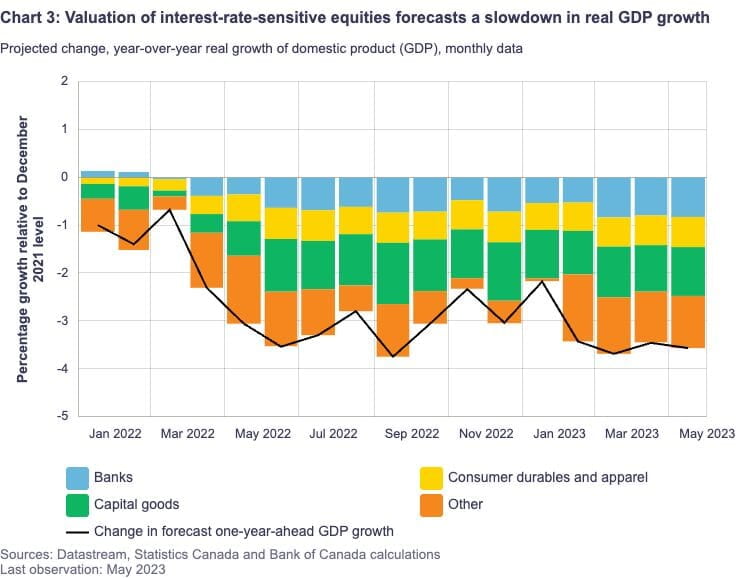Insights and Implication

The Canadian economy expanded at an annualized rate of 1.7% in the first quarter of 2024, missing forecasts. Real gross domestic product (GDP) likely saw a 0.3% monthly growth in April after the economy stalled in March. These latest figures provide valuable insights into the state of the Canadian economy and have significant implications for businesses, consumers, and policymakers. In this blog we’ll discuss the latest Canada’s GDP figures, insights and its implications.
Bank of Canada's Dilemma
The Bank of Canada has been grappling with high inflation, and these robust GDP figures present a dilemma. On one hand, the strong economic performance suggests that the central bank could break from its pause in interest rate hikes earlier than expected. On the other hand, the Bank may wait for more data before making a final decision.
Rate Hike Odds
Economists are divided on the timing of the next rate hike. While some believe that a rate increase could happen as early as next week, others see a higher probability for a hike in July. The central bank’s decision will likely hinge on additional data related to the labour market, which Statistics Canada will report on June 9, just two days after the Bank of Canada’s June 7 meeting.
Slower than Expected Growth
The 1.7% annualized growth rate in the first quarter fell short of expectations, indicating that the Canadian economy is not growing as quickly as anticipated. This slower than expected growth can be attributed to several factors, including:
Waning momentum as the quarter progressed, with activity earlier in the year benefiting from the end of strikes and mild winter weather
Cooling inflation and fading GDP momentum
Cyclical weakness evident in Canadian data since the beginning of the year
The mixed messages in the data suggest that the Canadian economy is struggling to maintain a consistent growth trajectory.

Implications for Monetary Policy
The latest GDP figures have significant implications for the Bank of Canada's monetary policy decisions. Andrew Kelvin, Head of Canadian and Global Rates Strategy at TD Securities, believes that the recent data makes a rate cut in June more probable. He cites reasons such as cautiousness around GDP growth, wage growth, and inflation expectations, and notes that the Bank of Canada may find support for rate cuts in the data, especially four consecutive quarters of GDP growth below 2%.
Kelvin emphasizes that the latest GDP report diminishes the argument for economic reacceleration, making it less likely for the Bank of Canada to maintain rates. He warns of cyclical weakness evident in Canadian data since the beginning of the year, indicating a probable rate cut not only in June but also in July to prevent overly restrictive policies.

Comparison to Official Estimates
World Economics, a research organization, estimates Canada's GDP to be $2.478 trillion in 2023, which is 11% larger than official estimates. This discrepancy highlights the importance of considering alternative data sources and methodologies when analyzing economic performance.
The official estimate for Canada's GDP was $2.226 trillion at the end of 2023 in purchasing power parity terms. World Economics has developed a database presenting GDP in Purchasing Power Parity terms with added estimates for the size of the informal economy and adjustments for out-of-date GDP base year data.
Implications for Living Standards and Productivity
Slower economic growth over the past year and near-record population increases fuelled by temporary and permanent immigration have put the spotlight on recent trends in Canada's GDP per capita. Real GDP per capita has now declined in five of the past six quarters and is currently near levels observed in 2017.
Recent declines in per capita output have brought concerns over Canada's weak productivity performance to the fore, since historically, much of the long-term growth in GDP per capita has reflected sustained improvements in labor productivity. This trend has negative implications for living standards and wage growth. Drawing on recent research at Statistics Canada that examines the link between investment, competition and productivity, the article provides a guide to understanding how Canada fell behind and how it can get back to trend.
Factors Affecting GDP Growth
Several factors have contributed to the recent trends in Canada's GDP growth:
Higher interest rates have led to businesses and households adjusting their spending and investment patterns
Exports and household spending have driven growth in 2023, while lower business investment and declines in residential construction have weighed on gains
Population growth has outpaced output growth, leading to a decline in GDP per capita
These factors highlight the complex interplay between economic, demographic, and policy variables that shape the trajectory of Canada's GDP growth.

Conclusion
The latest GDP figures for Canada reveal both opportunities and challenges for the economy. While growth indicators show resilience, certain sectors face headwinds that could impact overall momentum. Insights from Greenlight Capital highlight the importance of strategic investments and diversified portfolios to navigate these fluctuations. Investors should consider alternative fixed-income products to hedge against volatility and capitalize on potential growth areas. This approach not only mitigates risk but also aligns with sustainable economic trends.
Sources:



